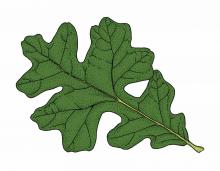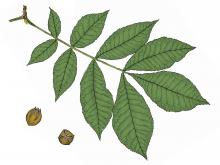Trees, Shrubs and Woody Vines
Media

Species Types
Scientific Name
Juglans nigra
Description
Easily Missouri’s most valuable tree, the black walnut provides the finest wood in the world, as well as delicious nuts. Both are in high demand and thus form an important part of Missouri’s economy.
Media

Species Types
Scientific Name
Quercus stellata
Description
Post oak has long been favored for fence posts and was valued by American pioneers. It has distinctive cross- or ghost-shaped leaves. It grows in rocky upland woodlands and in flatwoods on broad ridges.
Media

Species Types
Scientific Name
Quercus lyrata
Description
Overcup oak is fairly easy to identify. The acorns are almost completely covered by their knobby cups. The leaves have long, narrow lobes and wide sinuses. In Missouri, it grows naturally only in wet forests along the Mississippi and Meramec rivers.
Media

Species Types
Scientific Name
Quercus marilandica
Description
Blackjack oak is common in dry upland woods, especially ones that have been badly burned. It can grow on the poorest soils. It is rugged but not worth much as lumber. It's one of the first trees to be used as fuel.
Media

Species Types
Scientific Name
Carya cordiformis
Description
Of the several hickories in Missouri, bitternut hickory is the only one with long, bright yellow buds. Its common name refers to the bitter taste of the nut — but the flavor doesn't put off squirrels, mice, and deer!
Media

Species Types
Scientific Name
Carya illinoinensis
Description
The pecan, a type of hickory, is one of Missouri’s favorite nut trees. Originally pecan had a fairly limited, southern distribution, but today it is found in and out of cultivation nearly statewide, owing to the popularity of the nuts.
Media

Species Types
Scientific Name
Platanus occidentalis
Description
The white, smooth-looking limbs of sycamore rise over countless streams and river banks, as well as over sidewalks and city streets. The leaves, which somewhat resemble those of maples, can reach remarkably large sizes.
Media

Species Types
Scientific Name
Populus deltoides
Description
Named for the cottony fluffs of hairs attached to its tiny seeds, cottonwood thrives in moist lowlands near streams and rivers. It is Missouri’s fastest-growing native tree but pays for that distinction by being relatively short-lived.
Media

Species Types
Scientific Name
Salix spp. (about 12 species in Missouri)
Description
Exotic willows are available at lawn and garden centers, but there are several willow species that are native to Missouri. Most are rather humble colonizers of gravel bars, riverbanks, and lakesides. Many are important for human economic interests. All have a place in our wild ecosystems.
Media

Species Types
Scientific Name
Quercus prinoides
Description
The dwarf chestnut oak, though only 3–10 feet tall and the shortest of Missouri's oaks, can nevertheless produce abundant acorns that are relished by several types of birds and mammals.
See Also
About Trees, Shrubs and Woody Vines in Missouri
There are no sharp dividing lines between trees, shrubs, and woody vines, or even between woody and nonwoody plants. “Wood” is a type of tissue made of cellulose and lignin that many plants develop as they mature — whether they are “woody” or not. Trees are woody plants over 13 feet tall with a single trunk. Shrubs are less than 13 feet tall, with multiple stems. Vines require support or else sprawl over the ground.





















